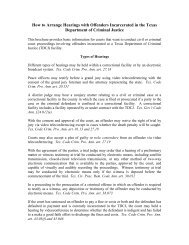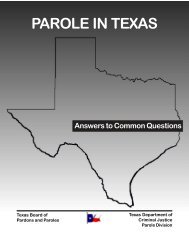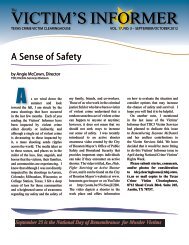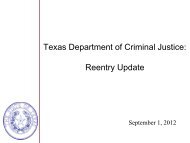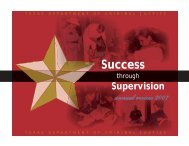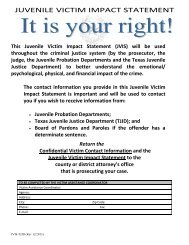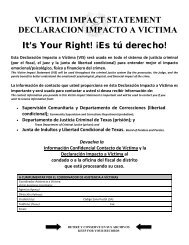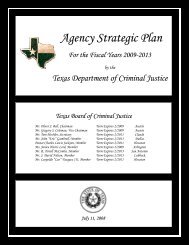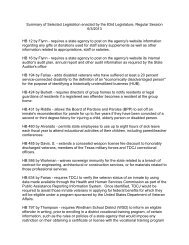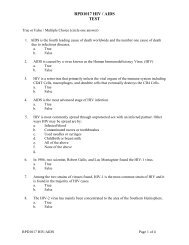TDCJ-CJAD Data Manual - Texas Department of Criminal Justice
TDCJ-CJAD Data Manual - Texas Department of Criminal Justice
TDCJ-CJAD Data Manual - Texas Department of Criminal Justice
Create successful ePaper yourself
Turn your PDF publications into a flip-book with our unique Google optimized e-Paper software.
Page 10 <strong>of</strong> 10PROGRAMS AND INTERVENTIONS INSTRUCTIONS:Most individuals participating in programs and interventions should be under direct supervision <strong>of</strong> your department.Exceptions are noted below.Reporting Pretrial Electronic Monitoring (ELM) cases: Offenders who are solely on PretrialSupervision (e.g., do not have an additional adjudicated or deferred case) and who are placed on electronicmonitoring should not be counted as direct. He / she should be reported in Section I.C. (Pretrial Services).However, the individual should be reported as an ELM participant.Program or Intervention: Place a code in the first column for each program or intervention contracted for oroperated by your department.ISP - Intensive Supervision Probation: Intensive probation supervision and services, usually limitedto 40 <strong>of</strong>fenders per <strong>of</strong>ficer, and created to divert felony <strong>of</strong>fenders from prison.SUR - Surveillance Probation: Designed to provide a highly intensive level <strong>of</strong> nonresidentialcommunity supervision to felony <strong>of</strong>fenders who would otherwise have gone to prison. Caseloadratios are usually 2 <strong>of</strong>ficers to 25 probationers.ELM - Electronic Monitoring: Most restrictive tool to provide probationer information whensupervising <strong>of</strong>fenders at risk. The electronic equipment monitors the absence or presence <strong>of</strong> aperson at a given location at a specific time.SCP - Specialized Caseloads: Grouping <strong>of</strong> probationers by problem area for supervision by an <strong>of</strong>ficerexperienced and trained in that problem area. Specialized caseloads are usually limited to 40<strong>of</strong>fenders per <strong>of</strong>ficer.DCT - Drug Court: Problem-solving court focused on <strong>of</strong>fenders who need rehabilitation and closesupervision to overcome drug and alcohol dependence.MHI - Mental Health Initiative: A program with specific funding from TCOOOMI for a defined group<strong>of</strong> mental health <strong>of</strong>fenders meeting specific diagnosis requirements.PSCT - Progressive Sanctions Court: An intervention strategy involving regular judicial review andmonitoring <strong>of</strong> <strong>of</strong>fender compliance to community supervision with appropriate, timely andconsistent use <strong>of</strong> sanctions and incentives.<strong>CJAD</strong> Designator: A designator is needed if departments have more than one <strong>of</strong> the same type <strong>of</strong> program orintervention. (For example, <strong>CJAD</strong> County CSCD operates two specialized caseloads for substance abuse and bothwould be coded as SCP:SAC.) If this situation exists, please contact <strong>CJAD</strong> and a unique identifier will be assigned.Program Type: For specialized caseloads, place a code in the second column. For other programs, leave thecolumn blank.SAC -- Substance Abuse CaseloadSOC -- Sex Offender CaseloadMIC -- Mentally Impaired CaseloadMRC -- Mentally Retarded CaseloadFVC -- Family Violence CaseloadGNG -- Gang CaseloadHRC -- High Risk CaseloadYTH -- Youthful Offender CaseloadCUL -- Culturally Specific CaseloadEMC -- Employment CaseloadNES -- Non-English Speaking CaseloadFIN -- Financial Problems CaseloadOTH -- Other Caseload- 21





